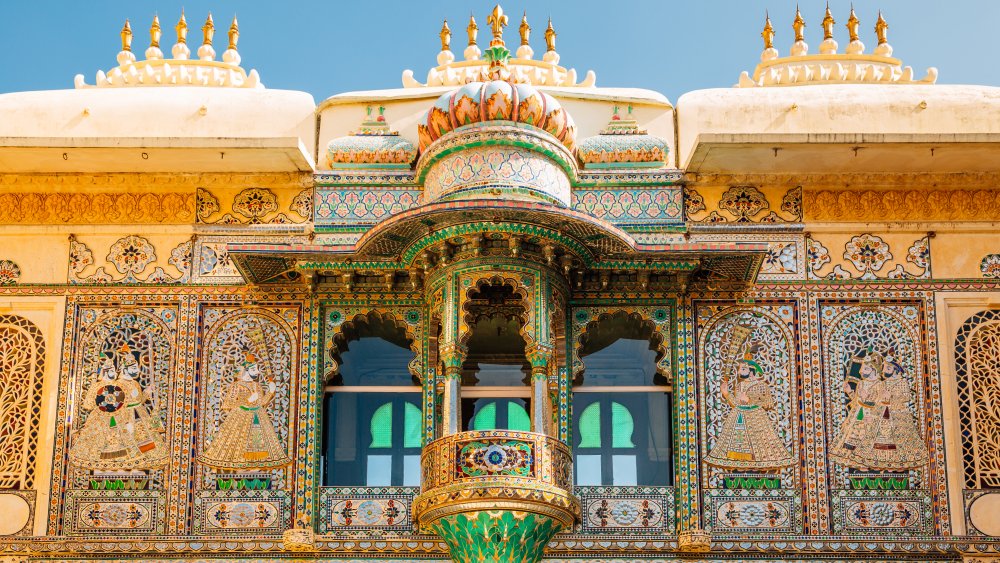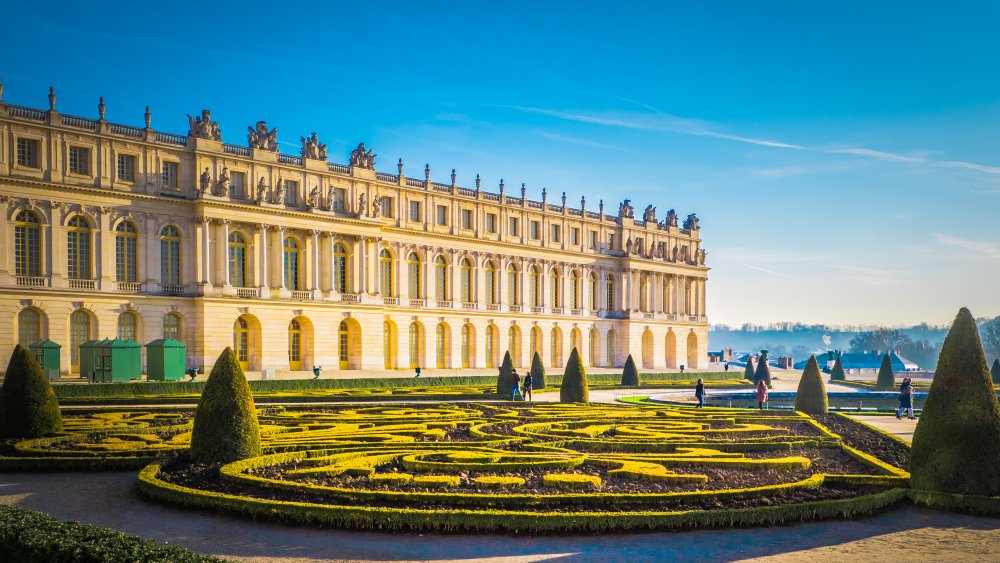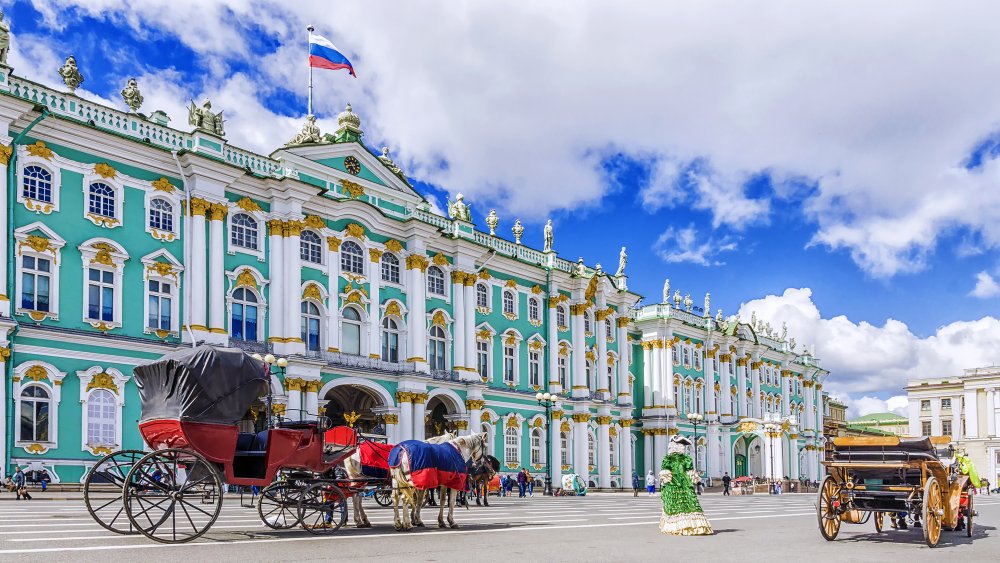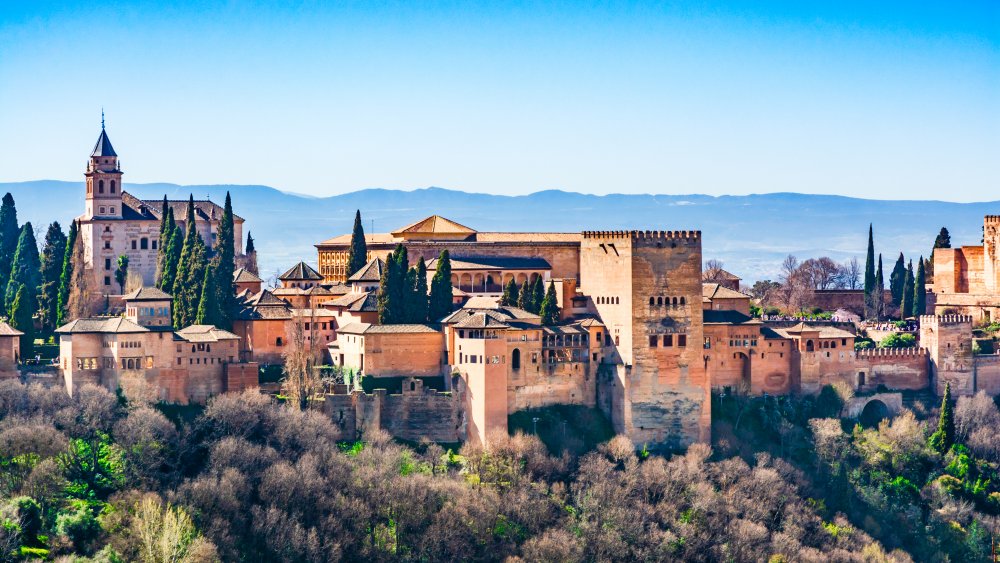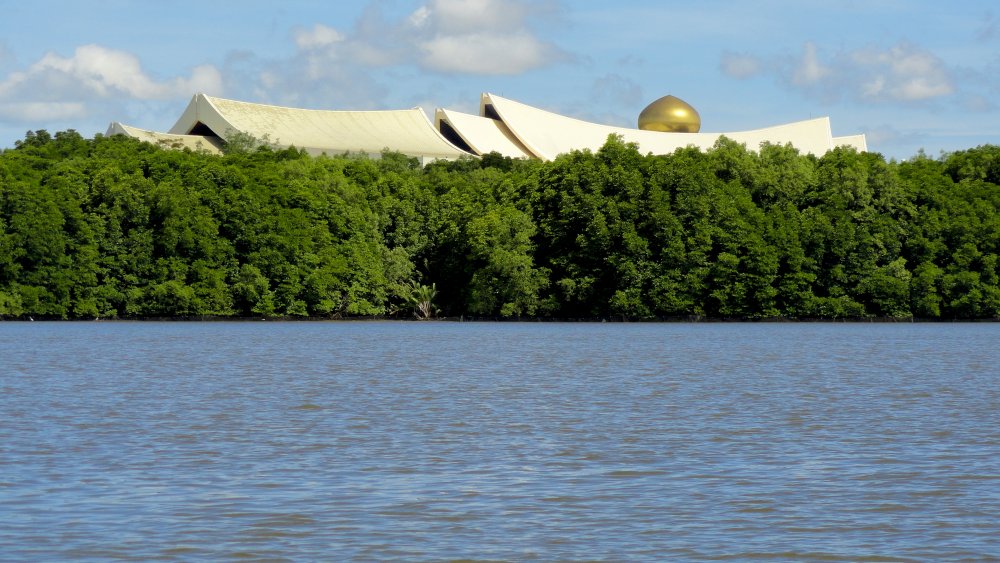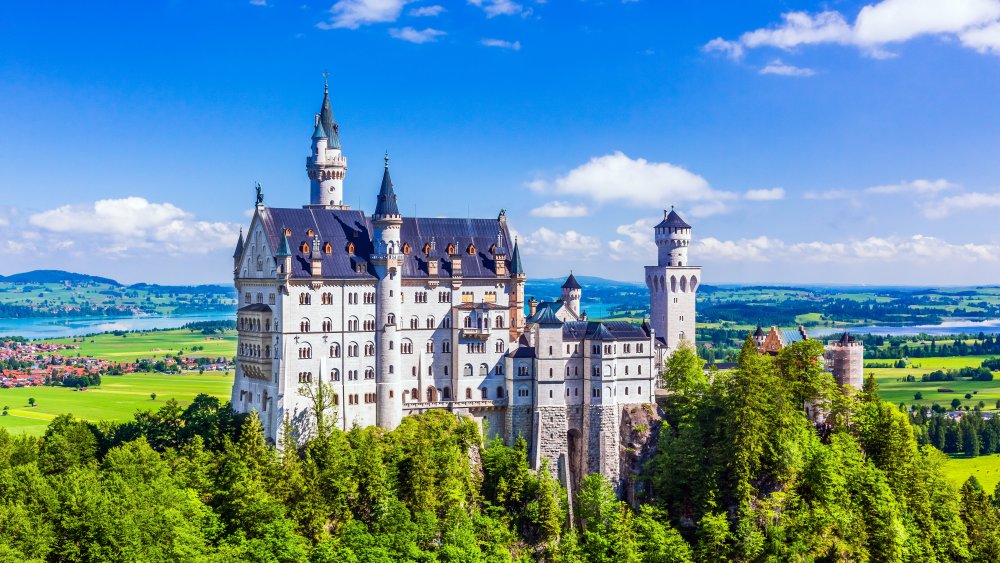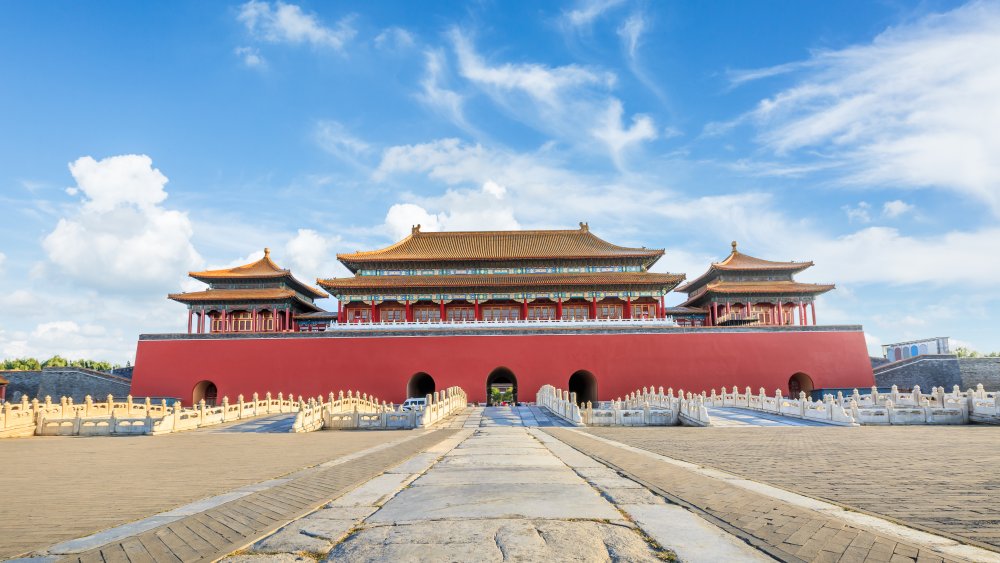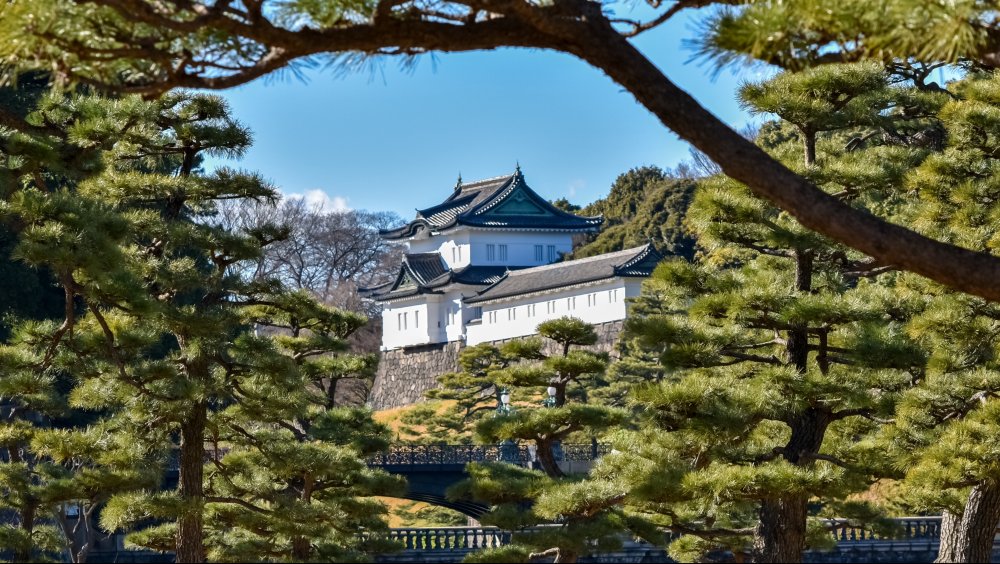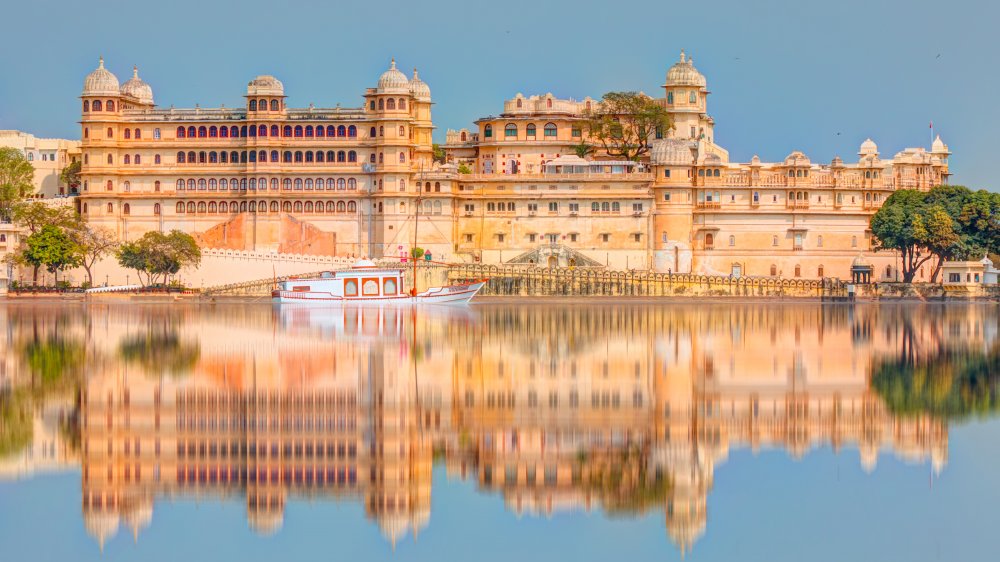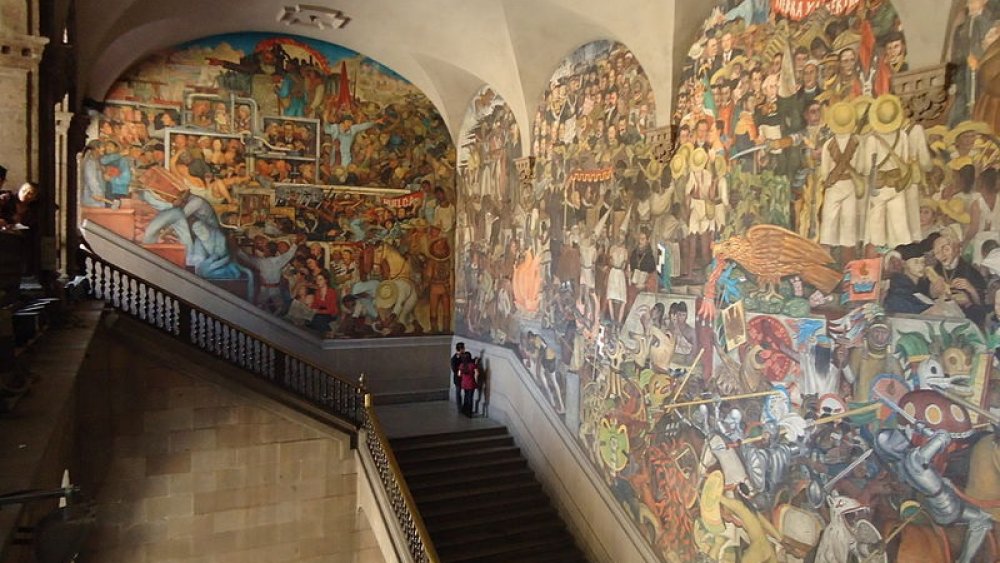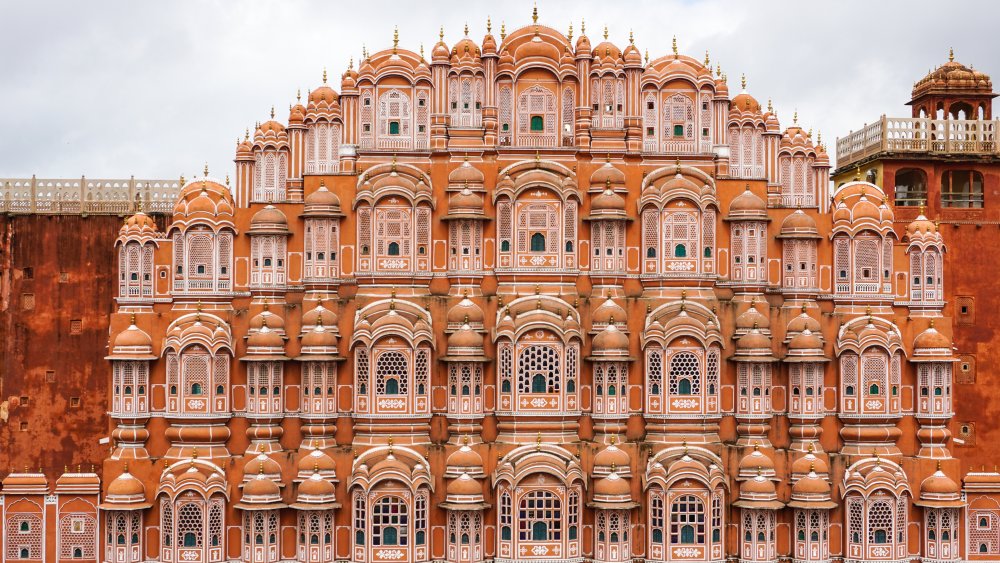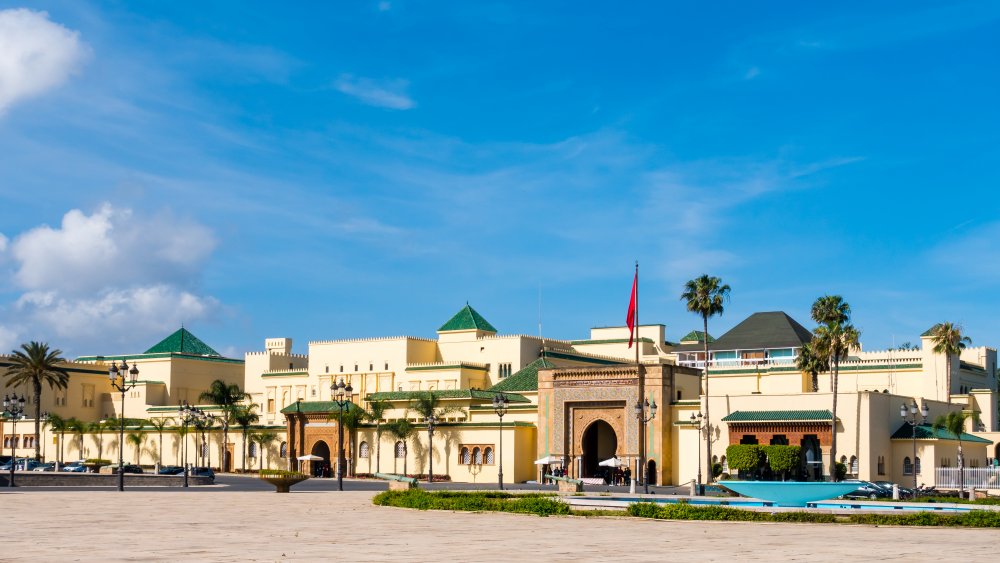The Most Over-The-Top Royal Palaces In The World
"Palace" is one of those words that immediately conjures up a very specific image: enormous, opulent, and ridiculous to think someone could actually live there, let alone think of the place as "home."
But plenty of people have lived in palaces over the centuries. As soon as civilization began, certain humans decided they were better than other humans and deserved to live in bigger, nicer abodes. At some point, things got really out of hand. These weren't just large houses — they were mini-cities, full of obscene displays of wealth. But even then, some royals looked at these massive pseudo-domestic power centers and said, "Hold my champagne."
Because there are some palaces that aren't just your standard royal residences. They took the idea of what a palace could be to the next level, and the ones on this list all have something special that makes them stand out in a crowded field. These are the most over-the-top royal palaces in the world.
The Palace of Versailles is incredible, inside and out
When you think of over-the-top palaces, you probably think of Versailles, and for good reason. The godfather of OTT, this French palace started as a modest hunting lodge before Louis XIV, the Sun King, turned it into what we see today. Love Money estimates the value of the land and palace at almost $51 billion. At one point, 5,000 people lived in the palace's 700 rooms, according to Google Arts & Culture. It's such a vast building that by the time the servants brought the king's food from the kitchens to the dining room, it was usually cold. It was home to a menagerie of exotic animals, a massive front gate completely covered in gold, and more decoration than your brain can really handle.
But the two things Versailles is most famous for are its gardens and the Hall of Mirrors. The geometric gardens were meticulously designed over decades. Eventually, there were "372 statues, 55 water features, 600 fountains, and over 20 miles of water pipes," as well as 400 different species of plants, including exotic specimens like pineapple, vanilla, and coffee. There were so many flowers in the 1600s that the smell made people ill.
The Hall of Mirrors is even more majestic. At a time when mirror-making was extremely difficult and they were obscenely expensive, the Hall was filled with 357 of them. It was still impressive enough in 1919 to be selected as the location for signing the treaty that ended World War I.
The Winter Palace was well-stocked
The Winter Palace in St. Petersburg was one of many homes for the Russian royal family until the revolution in 1917. Now it's part of the Hermitage Museum, and its 1,500 rooms are filled with priceless treasures like diamond-encrusted Faberge eggs, Ancient Greek statues, Egyptian mummies, and the famous Peacock Clock, a one-of-a-kind 250-year-old gold automaton that still works. In 2017, Love Money valued the whole shebang at about $6.5 billion. It's pretty impressive.
Then there's the wine cellar.
When Bolsheviks stormed the Winter Palace in 1917, they were more than a little peeved that the royal family had lived in such opulence. Then they went to the basement and discovered "the largest wine cellar ever known to history," according to PBS. That probably made them even madder, until they started drinking all of the booze. Those in charge of the revolution didn't want their forces drunk out of their minds, so they tried to stop the looting by putting up a wall. The mob knocked it down and kept drinking. Then the head honchos dumped the wine down the drains, but people just drank it out of the drainpipes, the perfect way to appreciate all that 1847 Chateau de Calme, one of the greatest vintages ever. There was so much wine in the giant cellar that the mob drank for weeks, and it still didn't run out. Only martial law put a stop to the bender. So yeah, it was a big wine cellar.
The Alhambra Palace is a graphic designer's dream
The Alhambra sits on a plateau overlooking Granada, Spain. Encyclopedia Britannica says it was built primarily between 1238 and 1358. The key thing to know about that time in that area of Spain is that it was controlled by the Moors, Muslim invaders, and they wanted to make a point that they were not going anywhere. So the Alhambra started life as a fortress.
That didn't mean it couldn't be pretty, though. As the palace's official website explains, "The greatest concern of the architects of the Alhambra was to cover every single space with decoration." And they do mean every single inch of the place. When they decided the walls and arches weren't enough of a canvas, they threw up some more totally unnecessary arches and columns just so they could decorate those, too. Ceramic and plasterwork were added to the walls, which were then surrounded with elaborately carved frames. One room's ceiling is made up of 5,000 "tiny cells," like a honeycomb, except every one is slightly different. Another room's ceiling is a star pattern made up of 8,000 individual pieces of wood, according to Lonely Planet.
Even though Muslim art "bans the representation of figures," that didn't give the decorators even a moment's trouble. The designs vary from stylized images of vegetation, to geometric shapes and intricately interlocked forms, to tons of calligraphy, including original poetry. There's even a special style of column found in no other building in the world.
Istana Nurul Iman broke records
The Sultan of Brunei is not hurting for cash. Business Insider puts him at the second richest royal in the world, with a net worth of $20 billion. That's actually a drop from his $40 billion in 1987, when he was the richest person in the world, period. So you'd assume a palace built around that time would befit a royal with stupid amounts of money.
And oh boy does it. Istana Nurul Iman has 1,800 rooms but is still technically classified as a "single-family residence," according to Atlas Obscura, which makes it the biggest house in the world. The palace's official website also notes that it holds the Guinness World Record for the largest residence of a head of state. It took two years to build and was finished in 1984, at a cost of over $1 billion.
Yet somehow, the sultan got his money's worth. The "house" is decorated with gold and Chinese silk. There are 38 different kinds of Italian marble used to make the 44 marble staircases. There's a helipad, five swimming pools, and a mosque that has room for 1,500 worshipers. The sultan's horses live in air-conditioned luxury in their stables, while the garage can fit 110 cars. (This is, however, room for a mere fraction of his collection of 5,000 custom-made Bentleys, Ferraris, and Rolls-Royces.) 5,000 guests can stuff themselves full of the best food in the banquet hall and then relieve themselves in one of the 250 bathrooms.
Ludwig II's construction projects almost bankrupted his country
Ludwig II of Bavaria had plenty of obsessions that consumed his life, but none more so than building castles and palaces, and he didn't worry about small details like the cost. Deseret News says he just wanted lots of buildings that were luxurious in the extreme.
Neuschwanstein (pictured) is the most famous of his creations — although technically it's a castle, not a palace. Perched on a hill, it's a fairy tale come to life, which is probably why Walt Disney used it as inspiration for Sleeping Beauty's castle. Inside, there are murals and tapestries everywhere, but the most incredible details might be in Ludwig's bedroom, where the decorations took 17 highly skilled woodcarvers four and a half years to finish.
Linderhof, on the other hand, is a palace and can be summed up in one word: MORE. More mirrors, gilt, candelabras, sculptures, paintings — the list goes on. But the real doozy was the Venus grotto, an artificial cave and lake where Ludwig would row in a cockleshell boat and put to use one of the first power plants in Bavaria running a "rainbow machine," which would light up the space in different colors.
Finally, there's Herrenchiemsee Palace, meant to be a copy of Versailles, which should tell you the kind of place it was. Most notably, the curtains in Ludwig's bedroom each weighed 100 pounds, and it took anywhere from 30 to 40 women seven years to make the bed coverings.
The Forbidden City lives up to its name
China might not have a monarchy anymore, but from 1420 to 1912, its emperors called the Forbidden City home. And they aren't kidding about the "city" part. China Highlights reports that the largest palace in the world is actually a complex of more than 70 palaces, made up of 980 buildings with over 8,700 rooms.
And Encyclopedia Britannica says the emperor was the only person in the world allowed to walk around any part of it without restrictions (hence the "forbidden" part for everyone else). Even the rest of the royal family and government ministers were only allowed in limited areas. According to Live Science, for the average dude, getting in had a rigorous bag check policy. As in, you had to be a eunuch if you wanted to enter and serve His Imperial Majesty.
Building the palace was a massive undertaking and took over one million workers 14 years to finish. Since the use of nails was considered "violent and inharmonious," the whole thing is made of interlocking joints. Good feng shui was vital, and the buildings were all designed to the most harmonious specifications. It's painted almost completely in red and yellow: Red is a symbol of good fortune in China, and yellow was only allowed to be used by the royal family as a sign of power. The clay tiles making up the floor cost over $4,000 each in today's money, while the land the palace sits on alone is worth an estimated $20 billion.
Tokyo's Imperial Palace is in a garden paradise
The Japanese royal family has only lived in Tokyo since 1868, after a political uprising meant they had to move from Kyoto, according to USA Today. Considering that they'd called Kyoto home for 1,000 years, Tokyo is very much new territory, and the palace is almost brand-new, only completed in 1968. Plus, it's not really that opulent. It's made completely of domestically produced materials (so no fancy Italian marble, for example) and is only two stories high aboveground, with a third level underground.
What it does have, however, is land. Namely, a lot of land in one of the most densely packed and expensive cities in the world. Imagine if some guy had a small house in the middle of Central Park, but then he also owned the whole park. That's basically the Japanese Emperor's reality. During the height of the Japanese property boom in the 1980s, The Telegraph says the land the palace stood on was estimated to be worth more than all the real estate in California, combined.
Most of the gardens are open to the public, and they are stunning. There's a moat surrounding the whole area, which is filled with landscaped gardens of cherry, plum, and maple trees, azaleas, koi ponds, and stone bridges. In some areas, you feel like you're in a forest ... in the middle of Tokyo. A full 20 percent of the trees in the entire city are on the palace grounds.
City Palace had an elephant fight club
The Maharanas of Udaipur began building the City Palace in 1559 and kept adding to it for the next 450 years, according to Trip Savvy. While India is a democracy, and the royal House of Mewar has no political power today, they still live in the palace, guarded by "turbaned retainers in full royal livery," per The Rough Guide to India.
Like the Forbidden City, the official tourism website for Udaipur says City Palace is actually a complex of 11 separate palaces, made completely of granite and marble. As well as the "marvelous assortment of courtyards, pavilions, terraces, corridors," and opulent rooms, the palace has actual hanging gardens, like the mythical wonder of the world in ancient Babylon. There's the area where the kings used to weigh themselves against silver and gold, and the arena that used to be used for elephant fights. Because no palace is really complete without a dedicated space for elephant-on-elephant violence.
The Hall of Private Audience houses perhaps the greatest treasure in the palace: two giant silver urns. Recognized by the Guinness Book of World Records as the "largest crafted silver objects in the world," they are each over five feet tall and can hold more than 2,000 gallons. While not even remotely travel size, Madho Singh II carted them to England in 1901 when he attended Edward VII's coronation. Singh didn't trust that sketchy Western water, so had the urns filled with water from the Ganges and took them with him.
National Palace is a work of art
The Palacio Nacional in Mexico City sits on a site that's had a royal palace since the time of the Aztecs. Lonely Planet says Hernán Cortés destroyed that palace, as he did so many things, in 1521. He then built a fortress in the same spot, using some of the materials from the rubble, meaning there are stones in the current palace that originally came from the Aztec one. In 1562, the Spanish crown bought the building for its own use, and eventually, it was home to the two short-lived Mexican emperors. Today, it's the seat of Mexico's executive branch, and US News and World Report describes the palace as a "massive, ornate building" with gardens and fountains.
And while the building itself is impressive, the reason it's such a must-see are the murals by celebrated artist (and husband of Frida Kahlo) Diego Rivera. Painted between 1929 and 1951, they're everywhere, and they're massive floor-to-ceiling masterpieces. That's just part of one pictured above. The murals depict the history of Mexico, from pre-Columbian indigenous life, to the Mexican Revolution, to the struggles of the modern socialist worker. There are fun cameos by people like Kahlo and Karl Marx. Unlike regular paintings, these priceless works of art can't be taken down and carted off to a museum. They are an inextricable part of the building itself, making the palace something truly special. Conde Nast Traveler calls it an "essential experience" that is "awe-inspiring."
Hawa Mahal was just for the ladies
In 1799, Maharaja Sawai Pratap Singh decided he needed a new palace in Jaipur, India. He already had a palace in Jaipur, mind you, but this new one was going to be for the ladies. It was actually quite considerate — at the time, royal women had to follow the strict Purdah system, which meant they couldn't be seen in public. As anyone who has experienced it knows, lockdown sucks. So Hawa Mahal, or "Palace of the Winds," was built to allow the women some connection to the outside world and involvement in local life.
According to the palace's official website, it's five stories tall in the shape of a crown, but the main feature is the windows. There are 953 of them in a honeycomb pattern. (Which begs the question, how many royal ladies are we talking about here?) The windows have intricate latticework, which hid the women from the view of the people in the square below but allowed them to watch regular city life as well as festivals. Each window obscures a small balcony designed so that air would flow through (this was before air conditioning, after all), and a fountain on each balcony made the spaces even more refreshing during hot Indian summers.
While the inside is relatively simple, there are still some opulent details. The top three stories are just one big room each, and the palace has no stairs, allowing the women to be carried around inside on palanquins by their servants.
Dar al-Makhzen Palace has an extremely exclusive school
The Dar al-Makhzen Palace, or the Palais Royal, in Rabat is home to King Mohammed VI of Morocco. It was built in 1864 to replace an older palace, according to Royal Central, and it has all the standard fancy palace stuff one would expect, like gorgeous mosaics, a parade ground, and immaculate gardens. But it has a lot more than that.
The royal family has other palaces (including, confusingly, another one called Dar al-Makhzen in Tangier), but there's no real reason they would ever have to leave this one. While it's mostly used today as an administrative government building, there's still plenty of fun stuff to do, thanks to the mosque, library, cooking school, and racecourse. There are also barracks for the guards, who mean business, since the palace is not open to visitors. If you want to check it out, at most, you can "get decently close to the Palace before the guards begin to get uneasy and ask you to leave."
Perhaps the most swish detail is that the palace is home to a school, the Collège Royal, which is exclusively for the education of the royal family. Nishan Magazine says it was founded in 1942 but essentially only exists when a prince or princess is the right age. The class that started in 2009, for example, consisted of Crown Prince Moulay El Hassan and just five other students, specially handpicked for their academic achievement (and, you'd assume, after an intensive background check).
